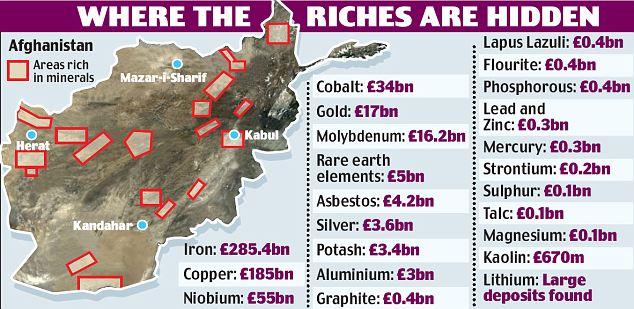Discovering $1 trillion worth of minerals with Airborne Hyperspectral Imaging
Afghanistan is a country formed by the violent continental collision of the Indian subcontinent with Asia. This is the reason for an abundance of rare and valuable minerals existing below the countries surface. Typically, it is hard to determine the quantity and quality of underground mineral sources without building mines and tearing through the earth to qualify initial presumptions. In war torn countries such as Afghanistan, these extensive operations are even harder to justify because of the danger the surrounding conflict poses to the deployed team. This has lead to the integration of remote sensing techniques such as airborne hyperspectral imaging within geological surveying, hyperspectral imaging sensors offer highly accurate qualification of the existence of precious materials within their field of view.
In 2006, U.S. researchers conducted airborne hyperspectral surveys over Afghanistan. These hyperspectral surveys looked at the spectrum of light reflected off the rocks to identify the light signatures unique to each individual mineral. The team mapped over 70% of the country over a period of two months.
The hyperspectral survey revealed Afghanistan may hold 60 million tons of copper, 2.2 billion tons of iron ore, 1.4 million tons of rare earth elements such as lanthanum, cerium and neodyum, and lodes of aluminium, gold, silver, mercury and lithium. An example of one source of rare earth elements is located in Helmand Province, this Khanneshin Carbonatite deposit is valued at $89 billion.

Jack Medlin, a geologist and program manager of the U.S. Geological Survey’s Afghanistan project reported “Afghanistan is a country that is very, very rich in mineral resources. We’ve identified the potential for at least 24 world-class mineral deposits.”
The researchers work has helped develop treasure maps which can inform mining companies what minerals are present, how much is there, and their location. The mining companies then bid for the rights for each deposit. Since the discovery of these minerals, the Afghan Government have signed a 30-year deal with the China Metallurgical Group worth $3 billion, this deal will allow them to exploit the Mes Aynak copper deposit. They have also awarded the rights to the country’s largest iron deposit to a group of Indian state-run and private companies.
Airborne Hyperspectral Imaging
Headwall’s airborne sensors are exceptionally small, light, and optically precise. Versions include the VNIR (380-1000nm), Extended VNIR (550-1700nm), NIR (900-1700nm) and SWIR (900-2500nm) spectral ranges. These sensors provide extremely high diffraction efficiency in its VNIR, NIR and SWIR versions. The A-Series, E-Series, X-Series, and M-Series sensors are available in Standard and High Efficiency designs.
To find out more about Headwall’s Hyperspectral Imaging sensors, click the button below:

This article is based on the report by LiveScience, to read to original piece, click here.


